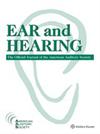Roadmap to a Global Template for Implementation of Ototoxicity Management for Cancer Treatment.
IF 2.6
2区 医学
Q1 AUDIOLOGY & SPEECH-LANGUAGE PATHOLOGY
引用次数: 0
Abstract
Ototoxicity is among the adverse events related to cancer treatment that can have far-reaching consequences and negative impacts on quality-of-life for cancer patients and survivors of all ages. Ototoxicity management (OtoM) comprises the prevention, diagnosis, monitoring, and treatment, including rehabilitation and therapeutic intervention, of individuals who experience hearing loss, tinnitus, or balance/vestibular difficulties following exposures to ototoxic agents, including platinum chemotherapy (cisplatin, carboplatin) and cranial radiation. Despite the well-established physical, socioeconomic, and psychological consequences of hearing and balance dysfunction, there are no widely adopted standards for clinical management of cancer treatment-related ototoxicity. Consensus recommendations and a roadmap are needed to guide development of effective and feasible OtoM programs, direct research efforts, address the needs of caregivers and patients at all stages of cancer care and survivorship. Here we review current evidence and propose near-term to longer-term goals to advance OtoM in five strategic areas: (1) beneficiary awareness, empowerment, and engagement, (2) workforce enhancement, (3) program development, (4) policy, funding, and sustainability, and (5) research and evaluation. The goal is to identify needs and establish a roadmap to guide worldwide adoption of standardized OtoM for cancer treatment and improved outcomes for patients and survivors.癌症治疗耳毒性管理全球实施模板路线图。
耳毒性是与癌症治疗相关的不良反应之一,可对各年龄段的癌症患者和幸存者的生活质量产生深远的后果和负面影响。耳毒性管理(OtoM)包括预防、诊断、监测和治疗,包括康复和治疗干预,适用于接触耳毒性药物(包括铂类化疗(顺铂、卡铂)和颅脑放射治疗)后出现听力损失、耳鸣或平衡/前庭障碍的患者。尽管听力和平衡功能障碍对身体、社会经济和心理造成的后果已得到充分证实,但在癌症治疗相关耳毒性的临床管理方面却没有广泛采用的标准。我们需要达成共识的建议和路线图,以指导制定有效可行的耳毒性治疗计划、指导研究工作、满足癌症护理和生存期各阶段护理人员和患者的需求。在此,我们回顾了当前的证据,并提出了从近期到长期的目标,以便在五个战略领域推进 OtoM:(1) 受益人意识、赋权和参与,(2) 劳动力提升,(3) 项目开发,(4) 政策、资金和可持续性,以及 (5) 研究和评估。目标是确定需求并制定路线图,以指导全球采用标准化的 OtoM 进行癌症治疗,并改善患者和幸存者的治疗效果。
本文章由计算机程序翻译,如有差异,请以英文原文为准。
求助全文
约1分钟内获得全文
求助全文
来源期刊

Ear and Hearing
医学-耳鼻喉科学
CiteScore
5.90
自引率
10.80%
发文量
207
审稿时长
6-12 weeks
期刊介绍:
From the basic science of hearing and balance disorders to auditory electrophysiology to amplification and the psychological factors of hearing loss, Ear and Hearing covers all aspects of auditory and vestibular disorders. This multidisciplinary journal consolidates the various factors that contribute to identification, remediation, and audiologic and vestibular rehabilitation. It is the one journal that serves the diverse interest of all members of this professional community -- otologists, audiologists, educators, and to those involved in the design, manufacture, and distribution of amplification systems. The original articles published in the journal focus on assessment, diagnosis, and management of auditory and vestibular disorders.
 求助内容:
求助内容: 应助结果提醒方式:
应助结果提醒方式:


